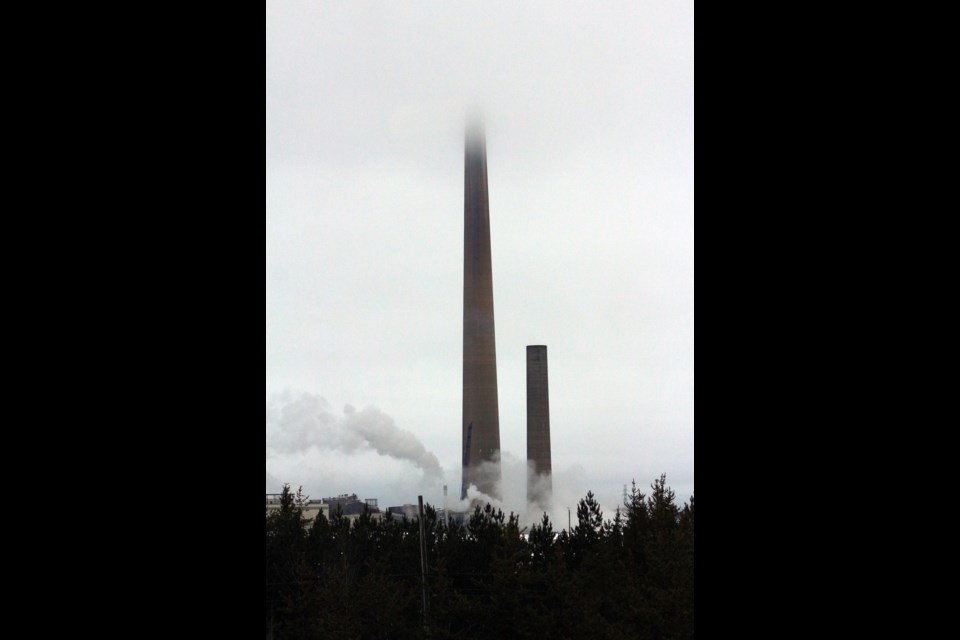Greater Sudbury's landscape is in for a major change.
In 2020, Vale will begin to dismantle its 381-metre (1,250-foot) Superstack, a structure that has become Greater Sudbury's icon since it was built in 1970. The mining company has made great strides in reducing its atmospheric emissions, to the point where the Superstack is no longer needed, said Stuart Harshaw, vice-president of Vale's Ontario operations.
Had Vale chosen to leave the structure standing after it's decommissioned in 2020, it would cost between $3 million and $5 million a year for care and maintenance.
“We have to have the most cost-effective operation in order to continue mining,” Harshaw said Jan. 24 at Dynamic Earth, where Vale announced its plans.
The Superstack stood silent in the background, grey clouds covering the top of it. It was a fitting sight to mark the end of an era.
“This marks an end of an era and a new chapter in our journey as a responsible and sustainable operation,” Harshaw said. “(The Superstack) is obviously very historic to our operations, and many people view it as an icon. Taking it out of service is a sign of how far we've come from an environmental perspective. It's a sign of how far we've come as a community in terms of what standards we're willing to accept and strive to obtain.”
When it was first built, the Superstack pumped out sulfur dioxide emissions in the range of 2,000 kilotonnes per year, Harshaw said.*
However, Vale is in the midst of its $1-billion Clean Atmospheric Emissions Reduction (AER) project. It's now about 70 per cent complete with $800 million spent to date, said Harshaw. When it's finished, it will have reduced sulfur dioxide emissions to about 20 kilotonnes, or 85 per cent. As well, particulate emissions — dust and metals — will be reduced by 40 per cent, the company said.
At the same time, the Clean AER project is being combined with Vale's surface facilities upgrade project, where the miner will transition from a two-furnace to a single-furnace operation, Harslaw said.
Vale will also build two smaller and more efficient 450-foot stacks to replace the Superstack. These smaller stacks will require less energy to operate, which will reduce greenhouse gas emissions from the Copper Cliff Smelter by about 40 per cent.
By changing to the smaller stacks, natural gas consumption is estimated to drop by nearly half, from 94 million cubic metres per year to 48 million cubic metres per year, Harslaw said. The savings is equivalent to the average fuel consumption of some 17,500 homes, or about one-third of all households in Greater Sudbury.
“We've been working on this for 10 years,” said Harshaw. “This is an evolution in terms of what our needs are.”
How it will tear down the Superstack has yet to be determined.
“I can't imagine that it will be anything other than a slow process due to its close proximity to an operational smelter and the community of Copper Cliff,” Harshaw said. “It will be very carefully managed.”
Dave Stefanuto, vice-president of North Atlantic Project and Base Metals Technology, said there will be many studies done over the next couple of years to best determine that process.
“There's no decision on timing, or how we are going to go about taking it down at this point,” he said.
Construction on the two smaller stacks will begin imminently, and will take about two years to complete, he said. The foundations will be finished by the end of this year. In 2018, the concrete shells will be constructed at about 137-140 metres high, Stefanuto said. Inside those shells will be steel liners, “almost like mini stacks inside each of the new stacks,” he said.
In the first half of 2020, the Superstack will be taken out of service and placed in care and maintenance mode.
“Within the Superstack is a stainless steel liner, and as soon as we stop our process gases and reduce the temperature, there's risk of advanced corrosion, so in order to make it structurally safe, we'll be removing that steel liner,” Stefanuto said. “There's a lot of critical work to go on this project, but we look forward to meeting the challenges ahead.”
*An earlier version of this story incorrectly stated annual emissions from the smelter in 1970 were 200 kilotonnes. The correct figure is 2,000 kilotonnes.
